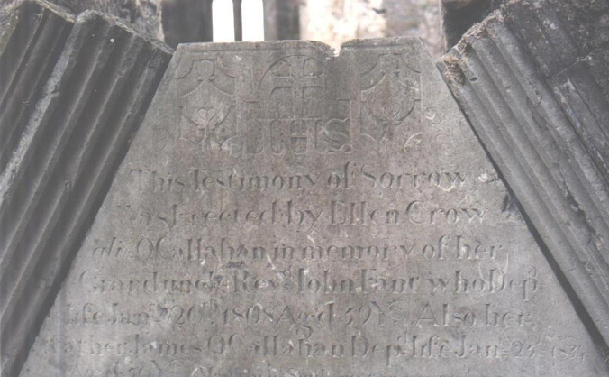[Return to Home page ]
Collegiate Church Kilmallock
Burial chamber of Fr John Fant
Stone plaque to Fr John Fant
The Fants in Ireland
Fr John Fant was the parish priest in Kilmallock between the years 1786 to 1808. When the famous
gaelic poet Aindreas MacGraith (one of the Maigue poets) felt death approaching in the year 1795,
he addressed from his daughters residence in Fantstown, where he stayed the following lines to Father Fant.
Os craite mise is go bhfuilim go breoite treith,
Gan chail gan chiste gan chruinneas gan choir gan cheim;
O tuaim ar mire is gur fiosach me leointe i mbaol,
Ni folair go gcuirfir me'om chlipeadh don ospideal.
Literal Translation:
Since I am tormented, sick and weak,
Without fame,without funds, without understanding,
Without justice, without position,
With my mind going and I knowing I am stricken and in danger,
It is imperative that I be taken quickly to hospital.
The note never reached Father Fant and the aged poet set off for Kilmallock on foot. He
died as he entered the town of Kilmallock at the house of some people named Hawthorne, and is buried in
their grave in Kilmallock cemetery. A monument was erected above his grave in April 1970.
Fr John Fant died on the 20th January 1808.He is buried in the old collegiate
church in Kilmallock.( Ref : Fant Genealogy)
Archives reveal that Fantstown castle was occupied by a Jason Fant up to the 1580s. It was his daughter,
Gennet who married Lord John Burgat around the late 1500s.John Burgat was originally from Athenacy manor
approximately 3 miles from Fantstown. Their son Henry Burgat joined the dominican priory in Kilmallock.
He had a reputation as a fine preacher. He would have resided in kilmallock abbey. Henry had a chalice
made in 1639 to commemorate his parents. Inscribed in the chalice are the words "we pray for the souls
of John Burgat and Gennet Ffant. This chalice was eventually presented to Henrys brother, William, who was a bishop
in Cashel, county Tipperary.The chalice is now kept in the parish of Drom in county Tipperary. Interestingly this parish
had a parish priest by the name of Patrick Fant in the early 1800s.Patrick Fant died on the 26/5/1847.
The Fant name was promenant in the towns of Fethard and Emly (in county Tipperary)
and Mitchelstown (county Cork) at this time. Some of these families may be traced back to the
Fants in Kilmallock and Fantstown castle.James Fant was an attorney in Kilmallock at the end of the 18th century and a direct descendent of the
Fants at Fantstown castle. He grew frustrated with
how the Irish catholic natives were being oppressed
by the landlords. When the landlords began enclosing the common lands used by the ordinary people for generations
it was the final straw. He formed a non violent group called the Whiteboys
to pull down the fences erected.
The movement
rapidly spread nationwide as did its agenda.The group revolted against the crippling
taxes and rents imposed upon the Irish who had no constitutional rights because of their religion.
This movement along with several others would eventually lead to the formation of the IRA.
Interestingly,one of the strongest links to the Fants at Fantstown castle may be found in the USA. According to folklore William Fant
comes up as the most likely name as the man who went to America.He left Ireland in the 1700's. There are currently over 2000
families with the name Fant living in the USA. Alfred E Fant of Austin, Texas completed his book "The Fant Genealogy" in 1975.
This book traces many of the Fants in America. The Fant name may also be found in Australia and the UK, often under
the name of Font and Faunt.



